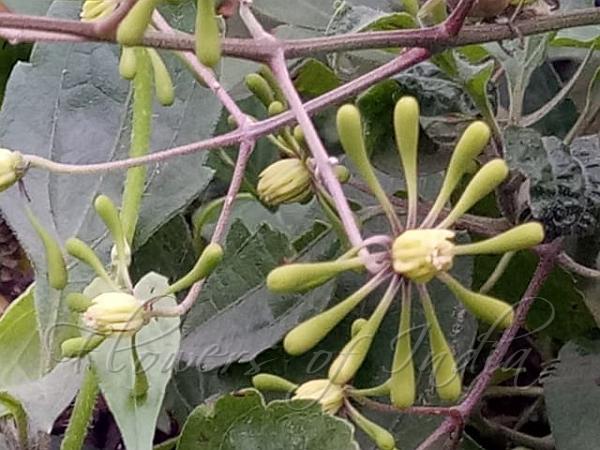|
| Ceylon Clematis |
|

|

|
|
|
|
Photo: |
Botanical name: Clematis zeylanica Family: Ranunculaceae (Buttercup family)
Synonyms: Atragene zeylanica L., Naravelia zeylanica
Synonyms: Atragene zeylanica L., Naravelia zeylanica
Ceylon Clematis is a climbing shrub with young
stem, leaves and buds densely hairy, and roots tuberous. Leaves are
2-3-foliolate; leaflets 4-12 x 3-8 cm, elliptic-ovate, base rounded,
margins distantly toothed, tip pointed or tapering, velvet-hairy
beneath, hairless above, basally 5-ribbed; at branch-ends leaflet
transformed into a 3-fid, hooked tendril, up to 9 cm long; leaf-stalks
5-10 cm long. Flowers are about 1.5 cm across, bisexual, at branch-ends
and in leaf-axils, in divaricately branched, up to 15 cm long panicles.
Sepals are 4-5, greenish yellow, 0.8-1 cm long, elliptic, velvet-hairy
without. Petals are 6-12, greenish yellow, 0.7-0.9 x 1-1.5 mm, linear
to spoon-shaped. Stamens are many, filaments ligulate; staminodes
10-14, petaloid. Carpels are many; ovule 1 per carpel; style 1.5-2 mm
long; stigma club-shaped. Sed-pods are many; 0.8-1 cm long, linear,
stalked, with spirally twisted, 3-4 cm long, feathery persistent style.
Ceylon Clematis is found in SE Asia. Flowering: October-April.
Medicinal uses: Ceylon Clematis is used in
Ayurveda. Vine is crushed and inhaled to cure headache; fresh stems
chewed in toothache; plant paste consumed with Borassus
flabellifer for chest pain. Young leaves paste applied on skin
diseases and ulcers, and on forehead for cold and headache; roots
of Eranthemum palatiferum pounded with leaves of Naravelia zeylanica
and applied to treat bone fracture. Crushed roots inhaled to cure cold
and fever.
Ceylon Clematis is used in
Ayurveda. Vine is crushed and inhaled to cure headache; fresh stems
chewed in toothache; plant paste consumed with Borassus
flabellifer for chest pain. Young leaves paste applied on skin
diseases and ulcers, and on forehead for cold and headache; roots
of Eranthemum palatiferum pounded with leaves of Naravelia zeylanica
and applied to treat bone fracture. Crushed roots inhaled to cure cold
and fever.
Medicinal uses:
 Ceylon Clematis is used in
Ayurveda. Vine is crushed and inhaled to cure headache; fresh stems
chewed in toothache; plant paste consumed with Borassus
flabellifer for chest pain. Young leaves paste applied on skin
diseases and ulcers, and on forehead for cold and headache; roots
of Eranthemum palatiferum pounded with leaves of Naravelia zeylanica
and applied to treat bone fracture. Crushed roots inhaled to cure cold
and fever.
Ceylon Clematis is used in
Ayurveda. Vine is crushed and inhaled to cure headache; fresh stems
chewed in toothache; plant paste consumed with Borassus
flabellifer for chest pain. Young leaves paste applied on skin
diseases and ulcers, and on forehead for cold and headache; roots
of Eranthemum palatiferum pounded with leaves of Naravelia zeylanica
and applied to treat bone fracture. Crushed roots inhaled to cure cold
and fever. | Identification credit: Shrikant Ingalhalikar, Pankaj Kumar | Photographed in Sakaleshpur region, Karnataka & East Siang, Arunachal Pradesh. |
• Is this flower misidentified? If yes,